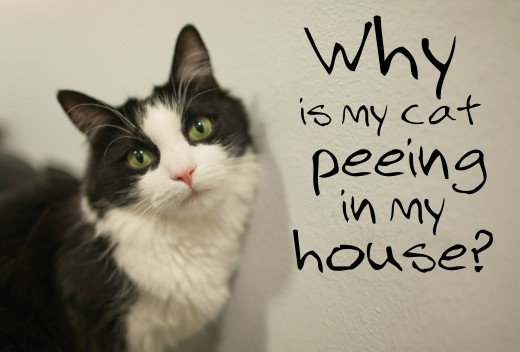Overview
Feline inappropriate elimination is a common behavioral problem reported to veterinarians, accounting for approximately 50% of all behavioral referrals. At least 10% of all cats will develop elimination problems in their lifetime. Unfortunately, it is also a leading reason for relinquishment of cats. Elimination problems can develop as a result of conflict between multiple cats in a home, a dislike for the litter-box type or the litter itself, as a result of a past or present medical condition, or a more complex issue of perceived inefficiencies within their environment. In this post, we will review some of the most common causes for inappropriate urination, and some steps to help correct the problem. We can often categorize the underlying causes in to four main groups including Medical, Litter Box Aversion, Territorial, and Attraction to Another Location.
Medical Problems
When you notice that your kitty is urinating outside of the litter box, the first step is to rule out medical issues with a Urinalysis and bladder radiographs (x-rays). The most common medical cause is “idiopathic stress-induced cystitis,” which accounts for approximately 75% of cases. This means that there is inflammation (and therefore pain and sense of urgency) within the bladder, but there is no identifiable cause. We do know that stress can precipitate these symptoms. Cats who are affected may have recurrent episodes with varying frequency throughout their lives if the underlying stressor is not identified and controlled (see below). The next most common cause is bladder stones, accounting for approximately 15% of medical cases, followed by urinary tract infections, which account for less than 5% of medical case. Less commonly, urinary crystals and bladder tumors are seen. If a medical problem is identified, your kitty will be treated in a way to resolve the underlying medical cause, and increase comfort.
Radiograph of a cat with a distended bladder
Litter Box Aversion
It’s no secret that many cats can be very particular about almost everything in their environment, so it’s no surprise that they may have strong opinions regarding the litter box; however, preference is not the only factor in litter box aversion. Cats who have had a previously negative experience in the litter box, particularly past episodes of pain (urinary obstruction, constipation), may also develop aversion. One common indication of litter box aversion is when episodes of inappropriate elimination occur near (but not in) the litter box, however this is not always the case. Cats typically prefer their litter box in a quiet, low-traffic, and easily accessible location. They often prefer an uncovered box for multiple reasons. First, cats have a sense of smell that is 60-100 times more sensitive than our own, and being cooped up within a box with excrement can be unpleasant…think Porta-Potty. Additionally, since cats are prey animals (as well as predators), they are instinctively more vulnerable during elimination. Being able to see potential threats is important for emotional security, even for indoor cats whose greatest threat may only be the vacuum cleaner. Most cats also prefer non-scented litter that is at least 2 inches deep for digging and burying.
Territorial
There isn't anything more adorable than a box of kittens, but these little cuties like to spread out and have their own privacy for litter box time!
One of the most important aspects of feline comfort is being able to distinguish, and have control over, their territory. It is essential to remember that cats may be threatened with any change in their environment, with some common examples including new pets, children (especially small ones that crawl and grab), house guests, conflicts with pre-existing pets, outdoor cats in the neighborhood, anything that alters the smell in the house…the list is endless! When cats do not have the appropriate materials to help them cope with these potential stressors, urinary and fecal marking may occur, as increasing their scent helps them feel more secure. To combat territorial marking, we must consider normal cat behavior. Cats use their scent glands on the face, paws, and tail base to mark things within their territory. This is what is happening when your kitty rubs her face and hind end, or scratches, on all aspects of your furniture, and then smells it immediately after. These pheromones let her know that she is safe and that these items belong to her. Helping to increase that sensation decreases the chance of your kitty marking in other ways. To help increase pheromone levels, we recommend using a synthetic pheromone called Feliway, which is available in diffusers and spray. Additionally, when threatened, cats prefer seeking a positional higher than the threat, since that is where they have the most chance of safety. This can be accomplished by adding vertical space, including cat trees and shelving. They also may seek places to hide, so providing covered hiding places for them is also important. In multi-cat households, we also recommend “spreading out the resources” so that your cats do not have to toilet, eat, drink, or play in the same area without it being their choice – nobody wants to be forced near their siblings 24-7!
Attraction to Another Location
As mentioned previously, cats like to toilet in places that are easily accessible, quiet, and have specific odors, and if the litter box is not meeting their needs, they often will find somewhere else that is more preferable. Additionally, when a cat has marked an area, it is essential to do a deep cleaning of that spot as soon as possible, as cat urine can soak through to the padding of the carpet, making it almost impossible to fully eliminate, and will continue to attract them to use this location. Using enzymatic cleaners such as “Nature’s Miracle” helps to naturally break down the components of urine to eliminate the smell. You should always avoid harsh chemicals or those with intense scents, as this may cause your kitty to want to mark over it.
Conclusion
Dr. Elise and one of our happy feline friends
Cat behavior is extremely complex, and the problems and solutions presented above only scratch the surface of the explanations and modifications for feline inappropriate elimination. The most important aspect is to first eliminate medical problems. After this is done, and you cannot immediately correct your kitty’s inappropriate elimination, please consult with your veterinarian at Southpoint Animal Hospital for further guidance. Behavioral marking is often due your cat’s perceived deficit of some aspect of their environment in which their emotional needs may not be being met. SPAH does offer an In-home Environmental and Behavioral Assessment, with Dr. Elise Hattingh, to evaluate your cat’s environment and relationships in order to maximize feelings of security, and therefore, eliminate marking. In an hour long visit, Dr. Elise will review the environment, watch the interactions between family members and other cats, and make suggestions based on your kitty’s behavior. This service has been extremely successful for many cats and owners to find peace in their homes.
For more information, consider attending Dr. Elise's Feline Behavior Workshop on Saturday, April 21. Details here!





